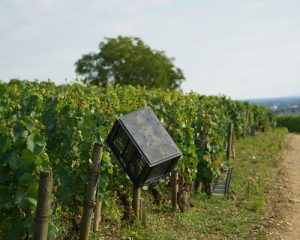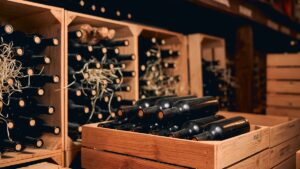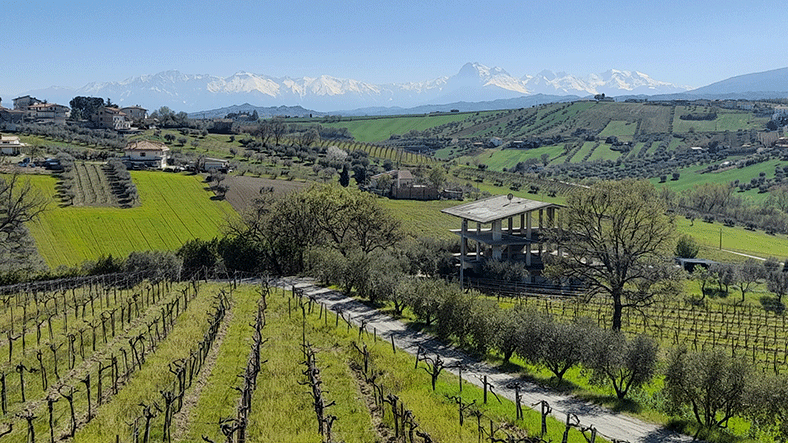
Recently, we were lucky enough to spend two exceptional days at Emidio Pepe’s estate in Italy’s Abruzzo region. Here’s the lowdown on our visit, what we learnt, and the wines we tasted.
We arrived at Azienda Emidio Pepe doused in a mid-afternoon, springtime sun, the sky a brilliant blue. All around us was a breath-taking landscape, with the snow-topped Monti Sibillini up ahead and the Gran Sasso to our right, both proud members of the striking Apennines. The vineyard blends seamlessly into this stunning backdrop, with the Adriatic Sea around ten kilometres beyond. Such a moving sight set the tone for what would be a fascinating few days, and Emidio Pepe’s granddaughter, Chiara, was waiting to welcome us.
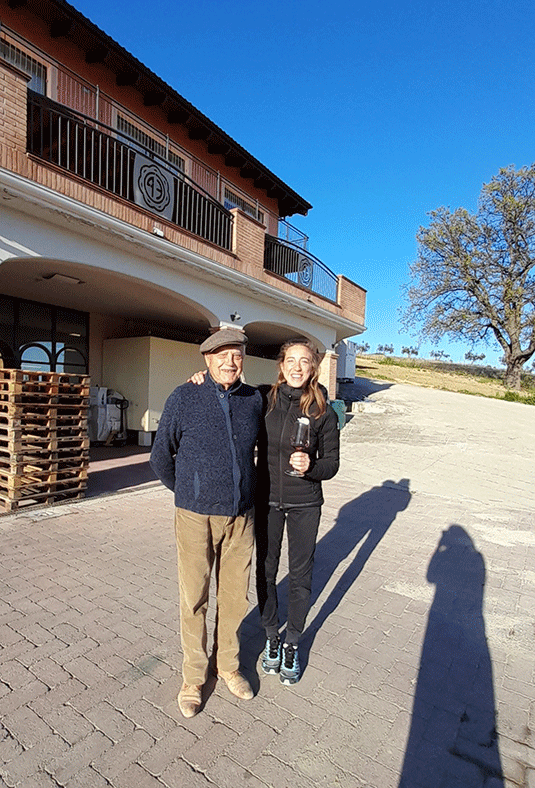
Emidio Pepe set up his domain in 1964 with a founding mission to craft fine, cellaring wines, an unusual idea in a region that didn’t share this vision for wine making at the time. Industrialisation hit Italy’s wine sector in the 1960s, and Emidio Pepe’s produce wasn’t received at home in the way he’d hoped; rather, it was in the US and Japan that he had his first big success. Despite local hostility to his methods, Emidio kept aside wine from each of his vintages to be aged, following his intuition that the estate’s terroir could produce fine wine. Rare in its scope, the domain’s winery now contains almost 350,000 bottles, and the ambition for Azienda Emidio Pepe has been transmitted to its determined next generation. Emidio’s daughter, Sofia, runs things in the cellar, and Chiara – his grand-daughter – has found her feet in the vineyards. Their respective specialisms go hand in hand, respecting the tradition they’ve inherited whilst adapting their methods to the living, breathing rhythm of the estate. Climate change is having an impact on how they work, and they are constantly striving to improve the quality of their wine.
Biodynamics and polyculture
The estate covers 27 hectares in all, 17 of which are used to grow vines. The remaining ten hectares of land are put to different use every year, with crops including ancient wheat varieties (the Senatore Cappelli, for example, which makes delicious pasta), rye, barley, and olives. Ideally, each vine parcel is associated with another kind of plot in constant rotation. Everything they grow is harvested by the estate itself then transformed; the wheat into pasta, for example, and the olives into olive oil. Fruit trees are planted next to the vines so that their roots can interact, as well as providing shade. This is all in keeping with Abruzzo’s historic agricultural mode of family-sized domains that grow in polyculture.
Biodynamics are central to the work at Azienda Emidio Pepe, for which they gained certification back in 2006. For several years now, Chiara has been working with biodynamic consultant Adriano Zago, who has several Italian wine estates under his wing, notably Foradori and Caiarossa. From a ‘common-sense’ farming perspective, the domain has been biodynamic since the beginning, though Chiara explained that working with Adriano Zago has improved the precision in her preparations and methods.
We picked a good moment to visit the domain, a time when many elements of the biodynamic process were in action. For example, it’s just before Easter that horsetail plant is imbibed into the soil of the vineyard, a preparation that stops fungal diseases spreading from the ground to the vines. All the preparations used here come from Vincent Masson in Burgundy (the son of Pierre Masson, who trained Adriano Zago), with the exception of the 500 and 501 which are made by the domain.
For another example of the meticulous care given, each and every vine is matched with a member of the vineyard team who is then responsible for following and understanding the plant from one vintage to the next.
The soil under the vines is alluvial due to the influence of the nearby mountain range, and its fertile nature has brought about many abundant harvests. More recently though, problems in these parts have stemmed from drought, which blocks photosynthesis and, therefore, phenolic ripeness in the grapes. Trying to counteract this, Chiara is experimenting with ploughing and putting a cover of plants between rows of vines. This year, she has planted a range of species alongside the vines to encourage a certain amount of protection and natural resistance. Chiara dreams of planting vines on the mountains of the Gran Sasso, a spot that would likely bring natural acidity and a pleasant freshness to her vines.
As we strolled into the vineyards, Chiara explained that these aren’t characterised by surface area but by volume, also referred to as ‘verticality’.
We started with a visit to the Pecorino vines, not the cheese but a grape variety native to the region. At the Azienda Emidio Pepe, these north-facing vines cover 1.7 hectares. They are never stripped of their leaves, and some of the vines are even trimmed later on to avoid early budding; Pecorino buds around ten days before the Trebbiano vines. It took the family quite some time to get to know this variety, so setting the right harvest date and optimising the foliage cover has proved to be a challenge. It appears the Pecorino grape is genetically similar to Pinot Noir, with small bunches, small amounts of juice, and thick skin. Emidio Pepe was the first to try making cellaring wines out of the local variety. The vine rows are placed 2.8 metres apart, as cultivation began with a system of pergolas in mind (structures that would support the vines as they grow). In the end, the Guyot Poulsard method was chosen, but the same space between the vines was kept in place; Chiara explained how this is crucial when drought hits, a way of growing grapes that are balanced in sugar and acidity.
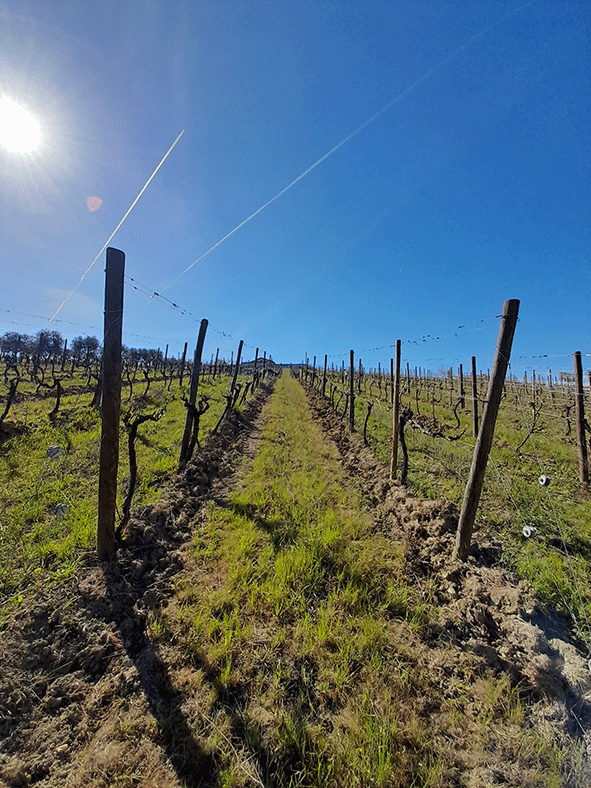
Trebbiano was up next, with vines of this variety planted in 2016 and becoming a site of several experimental practices. In 2020, for example, the domain welcomed the growth of other kinds of plant among the Trebbiano vines. This is a long-term element of their viticultural project, as these plants will naturally re-sow their seeds with every passing year. Chiara also uses this spot of the vineyard to try out a milk-based treatment, a method she learnt about at Domaine Chandon de Briailles in Burgundy.
Emidio Pepe’s Branella vines are cultivated on a Montepulciano d’Abruzzo plot, part of which has grown on pergola structures since 1974, surrounded by fruit trees. The rest is much more recently planted, as the old vines were pulled up six years ago. During these six years, various cultures made this parcel their ephemeral home, and eventually made way for vines transplanted from the Casa Pepe plot. Chiara tends to use rootstock that hasn’t been modified to avoid losing any of the wine’s typical rusticity. In her opinion, there’s too much tampering with rootstock as a way of adapting to different conditions such as drought, and these changes dilute the grape’s character. The older Branella vines grow on pergolas and are notably voluminous; the vines themselves reach up to two metres tall, and the plant cover at soil level is especially dense.
Looping back round towards the domain we find the Casa Pepe plot mentioned above. These Montepulciano vines, grown on pergolas, were planted by Emidio Pepe himself in the 60s. The old and the new come together here, as just next to Casa Pepe we find 0.4 hectares that have just been planted. On this spot, Chiara is testing a system that was once widespread in the region: the vines are held up with the help of four sticks.
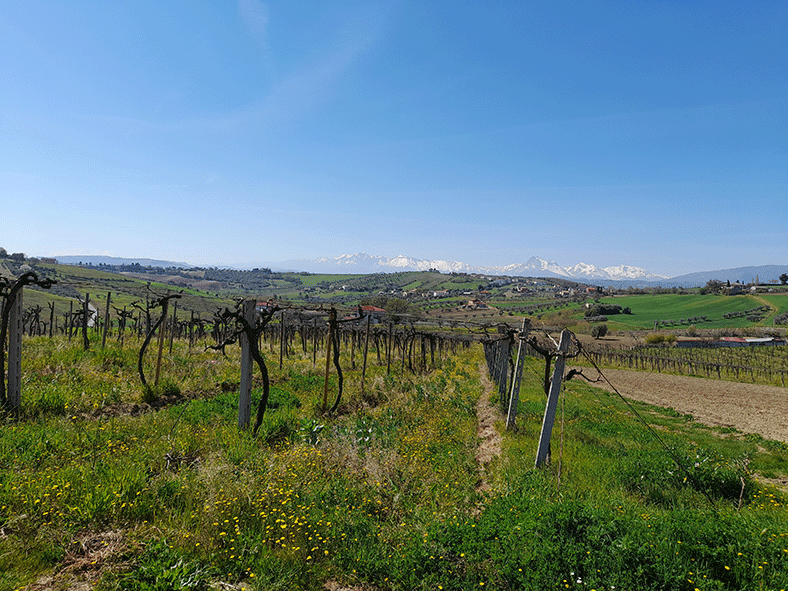
We finished off our vineyard tour with Donatella, a plot of Trebbiano vines planted in 1988, the grapes of which are used to craft the domain’s cellaring wines. Emidio Pepe’s older vines are tended to in a more traditional way, whilst the more recent plants are grown on pergolas. The latter is long to set up, as it’s only from the third year that the vines are allowed to grow to two metres, otherwise they won’t be as resistant. You won’t see many pergola systems in this region, as it’s a growing method that cannot be worked using machinery.
In the winery
Stepping into the winery confirmed the importance of tradition at the domain, as this space has been altered very little since the vinifications led by Chiara’s grandfather.
The white grapes are crushed underfoot in 350kg vats to extract their aroma, then they go into the vertical press; vinification begins once the juice arrives in varnished concrete vats. These specific vats have been in use at the domain since its 1985 vintage, as they are easier to clean and neutral containers in which to age the wine. Preserving the tartaric acid in the wine is easier this way, an important factor in times of drought. Emidio Pepe used to carry out malolactic fermentation in the bottle, meaning the wine could be protected without a big dosage of sulphur; malic acid levels are particularly low in the Trebbiano grape. Such a method isn’t possible now, however, due to rising temperatures, so alcoholic and malolactic fermentation take place simultaneously.
As for the red grapes, the leaves from their vines are removed by hand. Maceration is short and pressing takes place before all the sugars have had the chance to turn into alcohol, avoiding excessive extraction and high alcohol levels. The domain’s red wines are also vinified in varnished concrete vats.
The labels on Emidio Pepe’s bottles recount the history of his domain, reflecting how the family, their wine style, and even regional administration have changed over time. From the 2020 vintage, the wines can boast appellation labelling thanks to changes in legislation; in the past, vintners had to age their wine in oak casks to gain appellation status, but this is no longer the case. Another recent evolution is this: the old Montepulciano d’Abruzzo vines will be labelled according to their specific parcel, meaning that the domain can mark the difference between Casa Pepe and Branella.
Sticking with the labels, 2018 was the year in which the estate gained the right to add Selezione Vecchie Vigne to its bottles. This refers to a method that has always been practiced at the domain: whilst the wines made from young vines are bottled quite quickly and destined for the Italian market, cuvées from older vines undergo a much longer ageing process and are bottled later on. The latter, unsurprisingly, have a much greater cellaring potential and have always been exported. The difference in these two methods has thus only been made clear on the label very recently, a fundamental distinction to point out. And it’s these mature vine cuvées that make up the domain’s winery archive, labelled only once they’ve left the cellar.
…And the winery archive at Azienda Emidio Pepe is, indeed, the estate’s treasure trove. Every year, the family gets together to taste wines from all their past vintages, before deciding which should be put on the market. The reds over twenty years old are then decanted into another bottle and topped up with wine from the same vintage. It’s Sofia’s job to carry out this most delicate of tasks. The wines are then recorked with a new cork that mentions the year when the decanting took place. This process removes any deposits from the wine, making them more resistant to transport conditions. Chiara told us that the cuvées are more precise without their deposit, a conclusion reached from tests she carried out during many trips. From the 2021 vintage, the date of this operation will be stated on the label, too.
This winery is centrally important for the domain’s tasting records, as their vinification methods have never changed, meaning that the vintage effect is very marked.
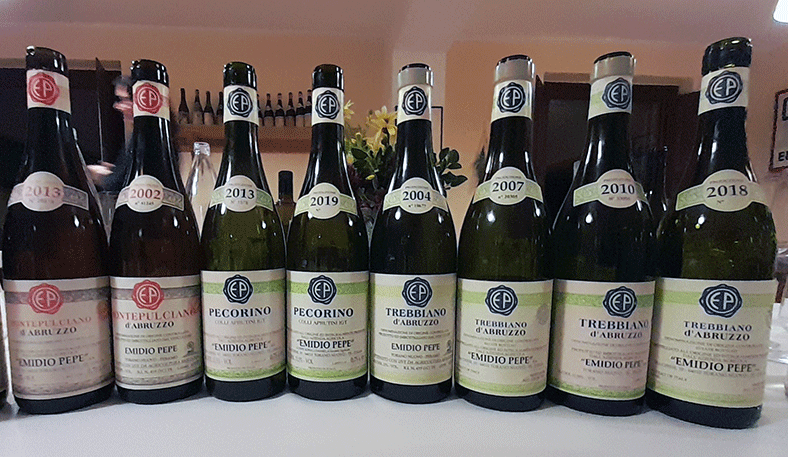
A fabulous tasting session
As part of our visit, we got the chance to taste several vintages of Emidio Pepe, and here are some of the notes we took to give you an idea.
White cuvées
Trebbiano (vat)
*Trebbiano young vines 2021: several lots of this vintage were directly pressed to retain their freshness (and not pressed by foot as described above). The grapes used are grown in the parcel where a milk-based treatment is being experimented. On the nose, the wine is still marked by reduction, and on the palate, it has a refreshing profile and nice bitterness.
*Trebbiano old vines 2021: reduction also makes itself felt in this cuvée, although a complex underscore is clearly developing.
*Trebbiano old vines 2020: a floral nose with citrus notes that follow through to the palate, with a pleasant bitterness that brings a certain freshness to the wine’s texture.
Trebbiano old vines (bottle)
*2018: nose of ripe pear, toasted sesame, round and ample mouthfeel lifted by grapefruit-like bitterness. A vintage to be enjoyed in its youth.
*2013: a surprising and complex nose, a bit like a vin jaune from the Jura, notes of curry and nuts, an ample palate that keeps a certain freshness, lovely length.
*2010: complex nose of white flowers, honey, wax, and verbena. A dense mouthfeel with citrus notes that recall yuzu and mint.
*2007: a very complex vintage with aromas of cooked apples, honey, and truffle. On the palate, this wine has a liveliness about it.
*2004: a gorgeous vintage, its nose evokes aromas of tea, white flowers, quince, and the structured palate brings a lovely minerality.
*1995 (enjoyed at the table): notes of gentle spice, saltiness, fine freshness and a length on the palate reminiscent of certain Burgundian grands crus…
Pecorino (bottle)
*2019: still quite closed and reduced, notes of white pepper come through. The palate is round and powerful.
*2013: a complex nose of honey, flowers, and kumquat, with a dense mouthfeel.
Note for future tastings that Emidio Pepe’s white cuvées shouldn’t be served too cool, and that they evolve in the glass. Overall, these wines are characterised by their complexity across vintages, with a broad aromatic palette and beautiful textures.
Red cuvées
Vats:
*Branella 2020: this cuvée carries aromas of blackcurrant, crushed strawberries, and aromatic herbs. On the palate, it is full of energy, with powerful tannins and notes of orange peel.
*Casa Pepe 2020: black fruits and camphor characterise this cuvée’s nose, whilst the palate has a bitter orange finish.
*Branella 2021: the strawberry side is there, as well as a hint of mint. Its tannins stand out on the palate, and the notes of orange peel appear again.
Bottles:
*2015: a nose rich in cherry and other dark fruits, with a hint of cacao. Pleasant texture on the palate and powdery tannins.
*2010: a fresh and minty nose with deeper notes of blackcurrant, dark fruits, and spices. A concentrated mouthfeel with fine tannins.
*2007: a nose of floral notes, cherry, and orange. A velvety and ample mouthfeel that finishes on a pleasantly bitter note.
*2005: complex nose of dark fruit, liquorice, orange peel, and a hint of balsamic. It has a supple texture and we find the dark fruit notes again, through an underscore of fine tannins.
*2003: beautiful freshness, smoky nose with citrus notes, roundness on the palate and a bitter finish. Reminiscent of certain Burgundy cuvées of the same vintage.
*2001: this vintage was decanted in 2019. The nose is marked by notes of leather, cacao, ripe black fruit and spices. The palate has an excellent balance of freshness and tension, with lovely tannins. This wine recalls certain fine Pauillacs.
*1993: nose rich in vegetal and smoky notes. This wine is beautifully mature with enveloping tannins. The palate is iron-rich with a pleasant sapidity.
*1975: earthy on the nose with aromas of mushroom and stewed fruit. We find the same notes on the palate, with the sumptuous addition of cherry and balsamic nuances, though this doesn’t take away from the cuvées freshness.
Like the white cuvées, the reds evolve once in the glass and reveal an extensive aromatic palette. Their finesse is what makes them stand out.
We were delighted to visit Azienda Emidio Pepe, an estate that has some wonderful days ahead of it. The wines produced here are truly fine; escapism in a glass and a call for gastronomic pairings. They have impressive cellaring potential and boast a distinctive character. All that qualifies a wine for a place in a wine enthusiast’s cellar.
Beyond the wines themselves, we were enchanted by the estate’s biodynamic and holistic approach, the way they tend to their vines, always keeping in mind the landscape around them and the team that works with them. A special mention goes to chef Pietro who cooked up some delights with fresh produce from the estate.
If any of you might be tempted by an excursion to this beautiful spot, the domain welcomes visitors to their guest bedrooms; a way for you to get an authentic look at Abruzzo’s viticulture up close!
Finally, we’d like to thank Chiara and the family for their very warm welcome.
You’ll find a variety of Emidio Pepe cuvées for sale here

